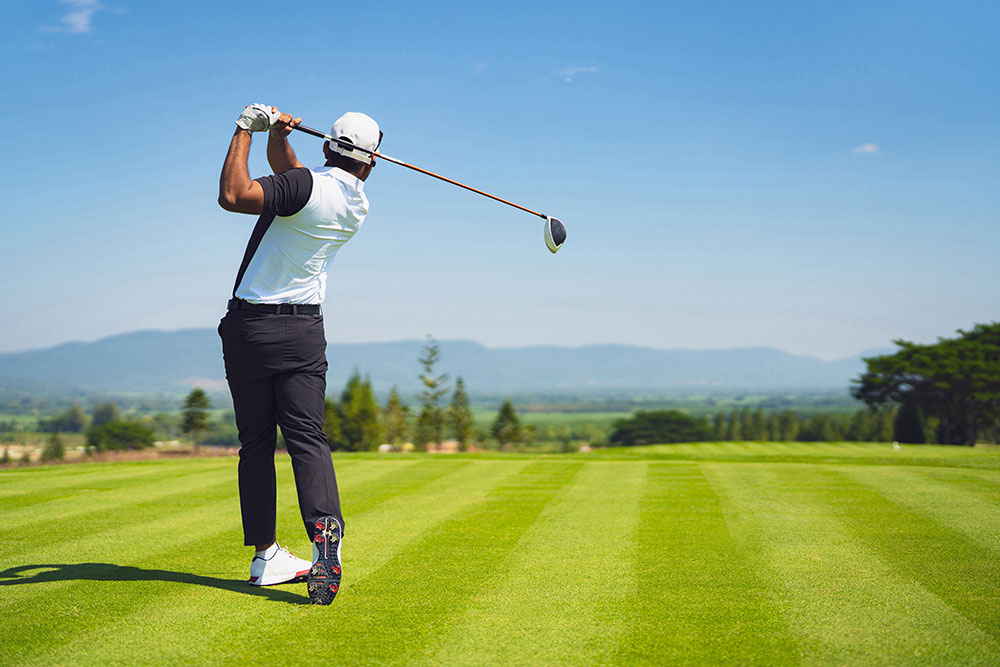
Dr. Richard Cunningham of Vail-Summit Orthopaedics & Neurosurgery (VSON) strives for excellence in orthopedic patient-centered care. Regarded as one of the best orthopedic surgeons in Colorado’s Rocky Mountains, both recreational and elite athletes appreciate Dr. Cunningham’s orthopedic knowledge, surgical skill, and bedside manner.
As the weather gets warmer, Dr. Cunningham shares insights in how to prevent golf injuries. As a sports medicine specialist with over 20 years of experience, and as a golf enthusiast himself, he understands the intricacies of the human body and how to keep it performing at its best on the golf course this season.
What are Common Golf Injuries?
One of the primary risks in golf is overuse injuries, particularly involving the wrists, elbows, shoulders, and lower back. Dr. Cunningham notes that the repetitive nature of the golf swing can lead to strains, tendonitis, and eventually soft tissue tears if proper technique and conditioning are not maintained. “The most common golf injuries we see are related to overuse,” Dr. Cunningham explains. “Golfers, especially those who play frequently or with improper form, are prone to developing issues like golfer’s elbow, rotator cuff tendonitis, labral tears in the hip joint, and low back pain.”
- Golfer’s elbow is also known as medial epicondylitis. With this, there is an inflammation of the tendons that originate from a prominent bone on the inside of the elbow.
- Rotator cuff tendonitis is an inflammation and associated bursitis of one of the rotator cuff tendons in the shoulder, most often the rotator cuff tendon on top of the shoulder called the supraspinatus.
- Labral tears in the hip occur when the labrum, which is like a gasket that surrounds the hip socket, peels off the edge of the bony socket. This can occur due to the repetitive and forceful hip rotation that occurs in a golf swing.
- Low back pain can occur from a variety of causes. There can be inflammation or even herniation of a disc in the lumbar spine or simply a strain of the paraspinal musculature.
How to Prevent Golf Injuries
To prevent these injuries, Dr. Cunningham recommends a comprehensive approach that includes:
Proper Technique: Ensuring that golfers have a solid understanding of proper swing mechanics is crucial. Dr. Cunningham advises, “A proper swing improves performance but also reduces the strain on vulnerable areas of the body.”
Physical Conditioning for Golf: Strength and flexibility are paramount in preventing golf injuries. “A tailored exercise regimen targeting core and spine stability, shoulder strength, hip strength, and overall flexibility can significantly reduce the risk of injury.”
How to Treat a Golf Injury
In the unfortunate event of an injury, Dr. Cunningham emphasizes the importance of a collaborative approach between the physician and your physical therapist. “From accurate diagnosis and treatment to personalized rehabilitation plans, each step plays a crucial role in facilitating a safe return to play.”
Treatment protocols for golf injuries may include:
- Rest: In some cases, temporary rest and time away from the golf swing may be necessary to allow the injured area to heal. Physical therapy and possibly an anti-inflammatory medication may be utilized.
- Physical Therapy: Physical therapy is a cornerstone of rehabilitation for golf injuries. It helps improve strength, flexibility, and overall function, gradually reintroducing golf-specific movements as the patient progresses.
- Gradual Return to Play: Returning to golf after an injury should be a gradual process. Dr. Cunningham advises, “Patients must follow their rehabilitation plan diligently and communicate closely with their healthcare team to ensure a safe and successful return to play.”
Dr. Cunningham’s holistic approach to golf injury prevention and treatment underscores the importance of proactive care and collaboration within the medical and rehabilitation community. By prioritizing prevention, addressing injuries promptly, and embracing a comprehensive rehabilitation strategy, golfers can continue to enjoy the game while safeguarding their long-term musculoskeletal health.
Dr. Cunningham states, “Mastering golf injury prevention requires a combination of education, conditioning, and teamwork. By taking proactive steps and seeking expert guidance when needed, golfers can minimize their injury risk and stay on course for a fulfilling, injury-free experience.”
Contact Dr. Cunningham and his team today to learn more about golf injury prevention to ensure you stay in the swing of things all season long!
